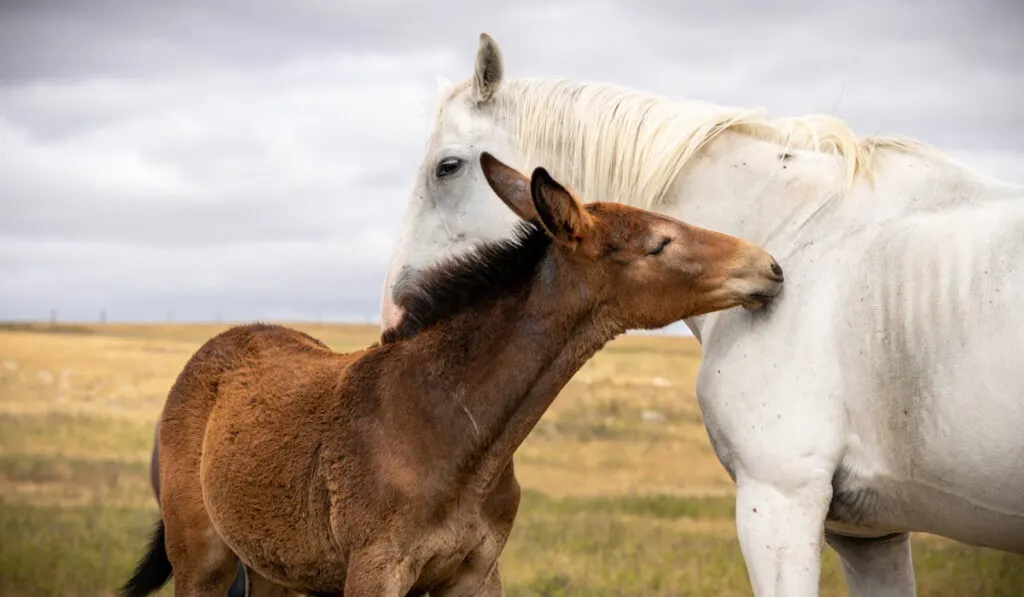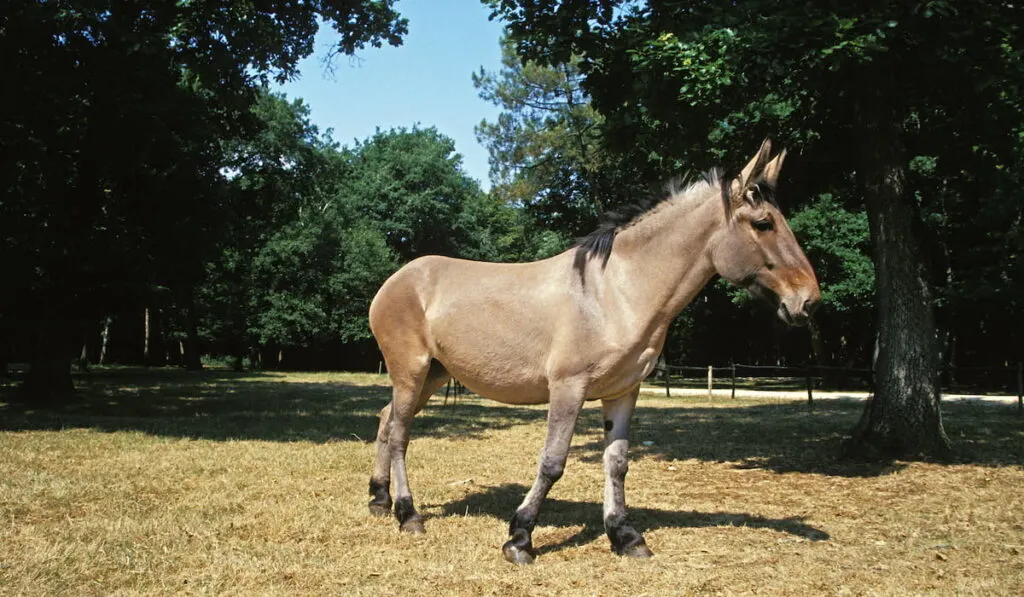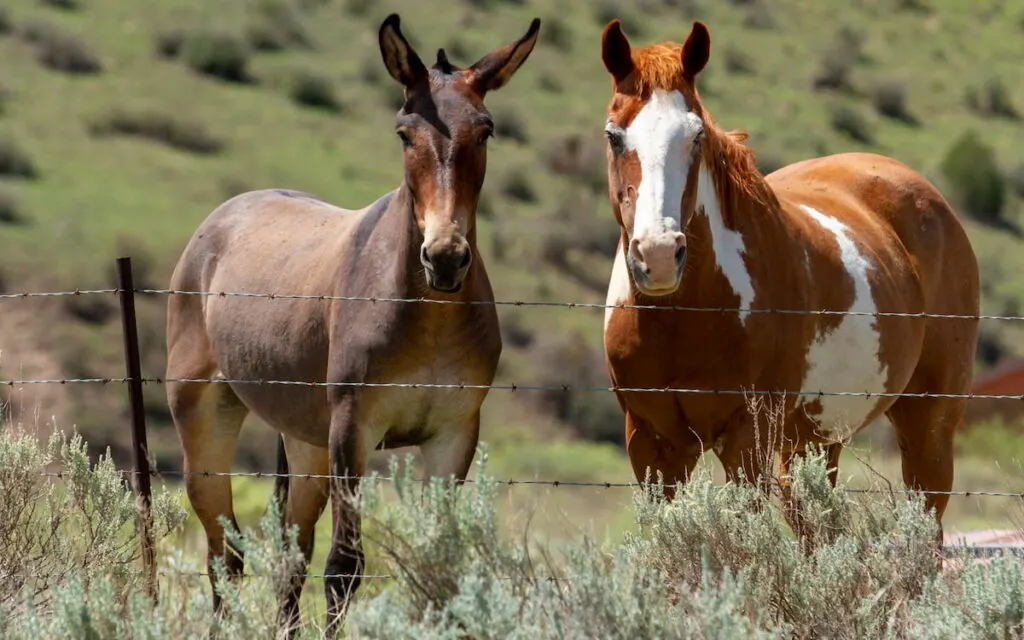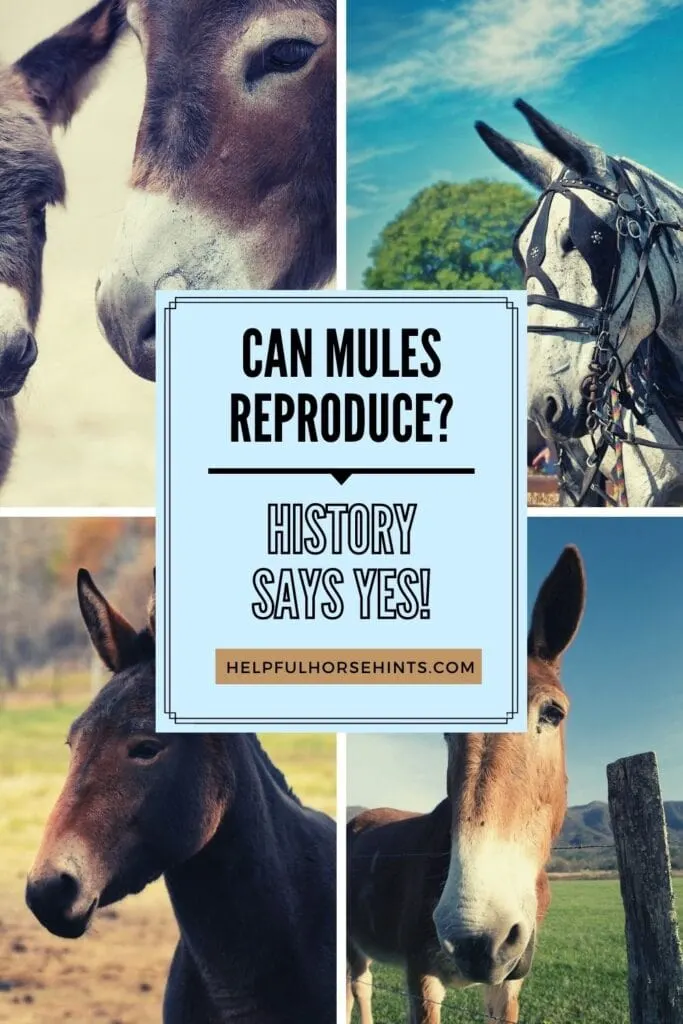A mule is the offspring of a female donkey and a male horse. These strong, surefooted animals have been used for thousands of years to carry goods and people around the world. They possess the best qualities of both parents – the size and strength of a horse, but the docile temperament of a donkey.
So, why is it that people don’t breed mules together to create more mules? The short answer – it’s virtually impossible.

The ancient Romans even had a saying about it: “cum mula peperit” or, when a mule foals (now we might say when pigs fly). Except, very rarely (once in a blue moon, as they say) mules can reproduce.
Table of Contents
Mules are (Usually) Sterile
Mammal reproduction is a tricky business, especially for equines. All of the right conditions have to line up perfectly – a healthy egg and sperm have to meet at the right place at the right time for conception to occur. This doesn’t even include the 350+ day gestation period it takes to produce a healthy foal.
Donkeys and horses also come from different species, which complicates things even further. The domesticated horse belongs to the classification Equus ferus caballus, and the donkey from Equus africanus asinus.
Horses have 64 chromosomes, but donkeys only have 62. When a horse and a donkey breed, the foal receives 32 chromosomes from the horse, and 31 from the donkey – a mule ends up with 63.

Having an extra chromosome can cause all sorts of problems in other species, but this abnormality doesn’t hinder the mule much except when it comes to reproduction. Most mules do not produce viable eggs or sperm, and are therefore rendered infertile.
Historical Accounts of Mules That Have Reproduced
Since the 1500s, there have only been about 60 cases of mules that have given birth, and many of these are anecdotal and not proven by scientific evidence. However, modern chromosomal testing has proven the viability of several fertile mules in recent years, although it is exceptionally rare.
In all of these cases, the fertile mule is female (and some have produced several foals) – no male mules have ever been known to produce offspring. However, some male offspring of these mule mothers are fertile, and go on to sire more foals themselves. How curious!
Can mules reproduce? Most mules are sterile but, very rarely, they can reproduce. However, you are more likely to be struck by lightning than own a mule that is able to have a baby.
Here are the stories of some of the mules who have had babies throughout history.
Greece, 480 B.C.
One of the first historical accounts of a mule producing offspring comes from Herodotus’ The Histories: “There happened also a portent of another kind while he was still at Sardis,—a mule brought forth young and gave birth to a mule.”
Such a thing was considered a very bad omen indeed (in fact, Herodotus considered it foreshadowing of Xerxes’ invasion of Greece).
A fertile mule would also disprove ancient theories of biology as determined by Aristotle and other Greek philosophers –an animal’s species is determined based on its ability to reproduce. So, a mule is not a separate species (like a horse or donkey).
But what is the species of a mule’s offspring, then? As it turns out, it’s either horse, donkey, or a hybrid like its mother.

Texas and Indiana, 1920s
A report in a 1939 article in the Journal of Heredity claimed that a mule named “Old Bec” had given birth to two offspring in the 1920s. One was sired by a donkey, and the other by a horse. The female foal from the donkey sire was sterile, but the male foal grew into a fine gaited Saddlebred stallion, and sired several of his own foals with no donkey characteristics.
That same article also named another mule birth in Indiana, a foal out of a mule mother and Percheron stallion. He too possessed no donkey characteristics. (source)
China 1981
In March of 1981, a filly was born to a black mule mother and donkey father in the Henan Province of China. Named “Dragon Foal”, scientists analyzed blood samples from both the foal and the mother in a process called karyotyping.
“Karyotyping is the process of pairing and ordering all the chromosomes of an organism, thus providing a genome-wide snapshot of an individual’s chromosomes” – that is, figuring out which chromosomes come from the horse, and which come from the donkey. (source)
Dragon Foal’s karyotype was unique, which made her a unique hybrid – neither mule, donkey, nor horse, but some special combination of all three. (source)
Nebraska, 1984 and 1987
Krause, a mule in Omaha Nebraska, gave birth not once, but twice! Both times, the father was a donkey named Chester.
Krause gave birth to “Blue Moon” (as in, once in a blue moon) in 1984, and “White Lightning” in 1987 (because sometimes lightning really does strike twice!).
It was reported that this was the first mule birth to be “scientifically verified,” as the case study of the Dragon Foal was not published until 1985.
United States, 1986 – 1995
Now comes the curious case of the fertile mule who gave birth to six foals. The first foal was male and looked more like a horse, sired by a stallion in the mule’s pasture. Two of her foals were sired by artificially inseminating donkey sperm, and were more mule-like in appearance (they also had 63 chromosomes).
She conceived two more foals with her own stallion offspring (as they possessed 64 chromosomes like a horse). So, not only was this particular mule exceptionally fertile – but some of her foals were fertile as well. (source)
China, 1988
A few years after the birth of the Dragon Foal, another horse and donkey hybrid gave birth in the Inner Mongolia Region of China. Both the mother and the foal were brought to a laboratory in Beijing for further study.
However, this time the mother was confirmed to be a hinny – which is a crossing between a male horse and a female donkey. Hinnies are less common than mules, as it can be more difficult to find the right match in size (and hinnies can have a harder time becoming pregnant than horses).

Like the Dragon Foal, this hinny foal had a unique set of chromosomes, and was genetically closest to a donkey like her father. (source)
Morocco, 2002
In August of 2002, a farmer rode her mule nearly 20 kilometers to the market to sell her goods. The very next day, the mule gave birth – much to the surprise of her owner and local villagers.
Scientists at a veterinary school in Rabat analyzed the foal’s blood, and they discovered that it was a cross between the 14-year-old mule and a local donkey.
The owner reported that when pack animals are brought to the market, they are left to their own devices – nobody can be sure which donkey was the father. (source)
Colorado 2007
A gangly, awkward male foal was born in Collburn, Colorado in 2007. His owners purchased a female black mule from a breeder the summer before. “Kate” abruptly gave birth in a field, surrounded by other mules and donkeys. (source)
Unfortunately, “Winterhawk’s Kule Mule Amos” passed away in 2010 after slipping in an icy pasture. He had a condition called windswept pasterns, which caused a malformation in his legs – and may have been caused by his unique set of chromosomes. (source)
As scientific advancements are made, we can more closely examine the link between horses and donkeys. Even today, we are still learning exactly what makes a species unique, and how the chromosomes work together to produce life.
Thousands of mules are still widely used around the world under saddle and as beasts of burden. The odds of a fertile mule giving birth is truly one in a million!
Source:
- https://apnews.com/302f530dc99cae7082ceb8e0ea6dc0f4

